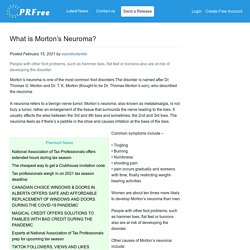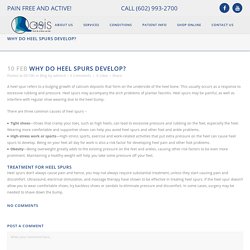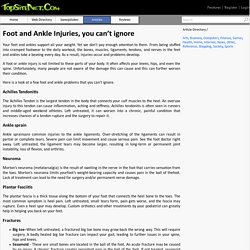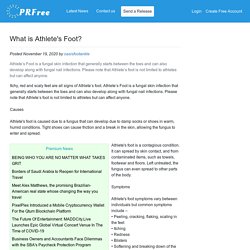

oasisfootankle
What is Morton’s Neuroma? Morton’s neuroma is one of the most common foot disorders.The disorder is named after Dr.

Thomas G. Morton and Dr. T. K. Morton (thought to be Dr. A neuroma refers to a benign nerve tumor. Common symptoms include – • Tingling • Burning • Numbness • shooting pain • pain occurs gradually and worsens with time, finally restricting weight-bearing activities Women are about ten times more likely to develop Morton’s neuroma than men. People with other foot problems, such as hammer toes, flat feet or bunions also are at risk of developing the disorder.
Other causes of Morton’s neuroma include: • Wearing high heeled shoes;such shoes cause the toe bones to be compressed, pinching the nerve, and causing stressing to the front of the foot • Wearing shoes with a narrow toe box, or ill-fitting shoes that cramp the toes • Foot deformity • Traumatic foot injury • Repetitive force, especially from running, tennis and other court sports. Why do Heel Spurs develop? Posted at 09:10h in Blog by admin4 A heel spur refers to a bulging growth of calcium deposits that form on the underside of the heel bone.

This usually occurs as a response to excessive rubbing and pressure. Heel spurs may accompany the arch problems of plantar fasciitis. Foot and Ankle Injuries, you can’t ignore. Your feet and ankles support all your weight.

Yet we don’t pay enough attention to them. From being stuffed into cramped footwear to the daily workout, the bones, muscles, ligaments, tendons, and nerves in the feet and ankles take a beating every day. As a result, injuries occur and problems develop. 5 Signs you need to visit a Foot and Ankle Doctor. We rely on our feet and ankles to stand, walk, run, jump, pretty much all movement.

Often, we stop to think about our feet only when we begin to experience discomfort or pain in the feet or suffer an injury. Even a small bump on the big toe can impact your balance and movement. 4 Great Benefits of Custom Foot Orthotics. Posted at 18:15h in Blog by admin4 You may have seen or used off-the-shelf shoe inserts to provide cushioning to your feet.

However, nothing beats custom-made orthotics to ensure your specific foot issue is addressed and that you find relief from pain and discomfort in your feet, along with prevention of long-term foot and ankle conditions. Customized to Specific Needs –Your foot structure is different from others’. It is important that your orthotics device fits perfectly to your foot to ensure your proper foot support in all the right places. 4 Unbeatable Benefits of Minimally Invasive Achilles Tendon Repair. The Achilles tendon is the largest and the strongest tendon in the body.

At the same time, it’s also subject to extreme stress when you run, jump or push off your foot. Repeated stress can lead to micro strains, or a partial or total rupture of the tendon. 6 Signs you should see a Podiatrist. Posted at 11:03h in Blog by admin4 A podiatrist is doctor who specializes in diagnosis, treatment and management of issues related to the feet and ankles.

They possess an in-depth understanding about the mechanics of the foot and have undergone intensive training to help you keep your feet and ankles healthy and pain-free. Many people have no idea about the right time to see a podiatrist or foot doctor. While you should have an annual checkup, here are six common signs that it is time to make an appointment with your foot doctor immediately.
7 Conditions where Custom Orthotics can help. Many foot and ankle conditions can be treated with specific rehabilitation solutions that can help you manage your issue.

One such treatment that can help in a wide variety of foot and ankle issues is custom orthotics. Custom orthotics are designed to your foot shape and size. Depending on your needs, your custom-molded orthotics will help to stabilize and provide comfort to your feet. What is Athlete's Foot? Itchy, red and scaly feet are all signs of Athlete’s foot.

Athlete’s Foot is a fungal skin infection that generally starts between the toes and can also develop along with fungal nail infections. Please note that Athlete’s foot is not limited to athletes but can affect anyone. Morton’s Neuroma. Posted at 14:34h in Blog by admin4 If your feet feel like you’re walking on a pebble, or a hot stone with shooting or burning sensations in the ball of your foot, it is likely you are suffering from a Morton’s neuroma.

Morton’s neuroma refers to swollen and thickened tissue around nerves in the ball of the foot. This can cause sharp, burning pain, numbness and even tingling, that may radiate to the toes. Morton’s neuroma occurs between the 3rd and 4th metatarsals and is more common among women, likely due to narrow shoes and heels. Do I have Verruca, Callus, or Corn on my foot? If there is something on your foot that is bothering you or it is painful, you should consult a podiatrist right away before it turns into a serious concern. Read on to understand the differences between a corn, a callus and a verruca. Callus A callus refers to an area of hard, thick skin that has developed over time due to friction or pressure. Calluses can develop across the ball of the foot or around the heel.
Neuroma or Pinched Nerve. A neuroma or pinched nerve refers to a thickening of nerve tissue. A neuroma can form in any area of the body, but the Morton’s neuromain the foot is the most common neuroma. It is sometimes referred to as the intermetatarsal neuroma and the most common location is between the third and fourth toe bones (metatarsals). Signs of Morton’s Neuroma. Calluses – Causes and Treatments. Posted at 19:21h in Blog by admin4 The term ‘Callus’ refers to thick, hardened layers of skin that develop as the skin tries to protect itself against friction and pressure. First you may notice a thick rough patch, which then turns into a hardened bump. The callus may also feel tender or painful to touch and the skin may appear flaky or dry.
Shin Splints: Cause and Treatment. You may remember shin splints from your younger days as the burning feeling in the shins after playing tennis on hard courts with thin soled shoes or after running around the neighborhood with your friends. As you grew older, you learnt to stretch and warm up adequately before exercise but shin splints can still occur. Causes of Shin Splints Medial Tibial Stress Syndrome, or shin splints, are a common injury that athletes and runners suffer from.
Shin splints usually appears as pain in the lower leg between the knee and ankle. This can be caused due to several overlapping factors, such as – Anterior Tibial Tendonitis – Causes, Signs, Treatment. Posted at 18:36h in Blog by admin4 Anterior Tibial Tendonitis refers to inflammation within the anterior tibial tendon. It occurs mainly due to overuse.
This tendon runs from the front of the shin, across the ankle to the inside of the foot. Excess Weight and Your Feet. Treating Broken Metatarsals. Morton's Neuroma Treatment. How to keep Diabetic Feet Healthy? Diabetes is a chronic condition that frequently causes nerve pain, and peripheral neuropathy (numbness in the hands and feet). When should I see a Doctor for my Ingrown Toenail? Effective Remedies for Heel Pain. If you have been experiencing heel pain for some time, wishing for it to go away, you should know that persistent heel pain requires proper diagnosis and treatment by a foot and ankle specialist. However, if your heel pain has just begun, you can try finding relief with the following remedies. If you have already tried one or two home remedies for your heel pain, without any relief, it is time to see a podiatrist who can identify the source of the problem and recommend the most effective treatment options.
Roll it out This temporary heel pain remedy can be done sitting down. You will need something tough that can roll, like a bottle or a tennis ball.Now, sit barefoot in a chair, and simply roll the object beneath each foot with controlled pressure. This helps to massage any strained tissues, for example, if you have plantar fasciitis. You could try this exercise with a plastic bottle filled with water and chilled in the freezer.
5 Foot Care Tips to Prevent Injury in Summer. After a few months of spending all your time at home, you may want tomake the most of your summer as much as (safely) possible! Why is it important to wear shoes at home? 5 Preventable Foot conditions. Read on to know more about 5 common foot conditions that can be easily prevented through timely and proper care. Athlete’s Foot Athlete’s Foot is a fungal infection that usually develops on the soles of the feet and in between the toes. Itchy, dry, scaling skin are common signs. If the condition worsens, inflammation, cracks, and blisters may occur. Athlete’s Foot can be easily prevented by – • keeping your feet dry • changing your socks frequently • wearing shoes in public facilities, such as locker rooms Plantar Fasciitis A thick band of tissue – plantar fascia – stretches from the heel to the toes.
Which Shoes are Best for your Foot Arch? Not all feet are the same. How to determine whether I need Orthotics? How to take care of your feet at home? Are Orthotics Effective? Foot pain may be linked to Heart Disease. What should I do if my toenail is falling off? 5 Common Foot Problems. All you need to know about Foot Orthotics. How Rheumatoid Arthritis affects the Feet. Difference between Rheumatoid Vs. Osteoarthritis. What is Custom Orthotics Treatment?
Did you know Custom Orthotics can Relieve Back Pain? What are Bone Spurs? What are Claw Toes and Mallet Toes and How can they be Treated? Diabetes and Foot Conditions. Does your heel hurt? Barefoot Running – Safe or Unsafe? Common Reasons for Chronic Foot and Ankle Pain. You Need a Podiatrist if you have Diabetes. Foot Conditions in Seniors. Treating Ingrown Toenails. Moodle. What is Heel Pain? Foot and Leg Problems in Children. Pain in the ball of the foot? Interesting Facts about Paintless Dent Removal. Moodle. 525: SSL handshake failed. Ankle Swelling – What does it mean? Painful Heel and Arch. Ankle Weakening or Loosening – Ankle Instability. Morton’s Neuroma Treatment. Foot And Leg Problems Among Kids. When do I need to replace my custom orthotics? 8 Incredible Travel Tips for Women. Managing Plantar Fasciitis with Orthotics.
11 Common Overuse Injuries in the Feet and Legs. What is the difference between Heel spurs and plantar fasciitis? Signs of Common Foot injuries. Bunions – Signs and Treatment. When to Visit a Foot and Ankle Surgeon. 5 Excellent Tips to protect your Children from Sports Ankle Injuries. How To Choose The Right Running Shoes. Caring for your Feet if you have Diabetes. Ankle Sprains and Healing. 8 Incredible Travel Tips for Women. 3 Foot Conditions Caused during Cold Weather. Bone Spurs – Causes, Risk Factors and Treatment. Why Physical Therapy is Important. Can Athlete’s Foot spread from one person to other? Do not Ignore Ankle Sprains.
5 Types of Severe Foot Fractures. 4 Types of Toenail Infections. Why Physical Therapy is Important. Common Dancer's Foot Problems and Prevention. All You Need To Know About Hammer Toes. Foot & Ankle Swelling. Addressing Common Foot and Ankle Issues. Heel Spurs and Plantar Fasciitis are Different. Your Bunions may cause Severe Foot Conditions. Heel Spurs Treatment. Foot Pain may indicate Heart Disease. Troubled by Heel Pain? Why are High Heels NOT so Good? Why are High Heels NOT so Good? 7 Solutions for Runner’s Feet. Custom Orthotics and Foot Conditions. What causes Toenail Fungus? Which sandals can be worn all day? Why over-the-counter orthotics is not as effective as custom orthotics? 6 Common Reasons to See a Foot Doctor.
Don’t Ignore a Sprained Ankle! What causes Stress Fractures? Do Not Take a Diabetic Foot Ulcer Lightly. Cuboid Syndrome. 9 Reasons Why Athletes Should Visit A Podiatrist.